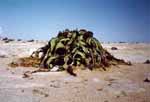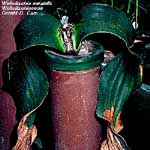
Welwitschia in habitat (5) [Dieter von Willert].

A cultivated specimen (2) [Gerald D. Carr].

A cultivated specimen showing pollen cones (7).
Common names
Tree tumbo (4), tumboa (local native), welwitschia (horticultural).Taxonomic notes
Since the family (Welwitschiaceae Markgraf.) and genus are monotypic, all data are presented hereunder (pending development of a more in-depth treatment). Some authors asign the family to a monotypic order, Welwitschiales.Syn: Welwitschia bainesii.
Description
Dioecious perennial plant with short stem and taproot. Beyond that, the plant is often described as 'bizarre', 'weird', or (more explicitly) 'unlike any known plant on earth'. Its short, woody, unbranched stem is surmounted by two strap-shaped leaves that grow from a basal meristem throughout the life of the plant, becoming twisted and frayed with the passing centuries. The leaves contain numerous subparallel veins that may anastomose or terminate blindly in the mesophyll (this character, again, is unique in Welwitschia among the gymnosperms). Stomata occur on both leaf surfaces. The woody stem widens with age to become a concave disc up to a meter across, from which grow small ramified branch systems that serve only to bear pollen and seed cones (6). The branched reproductive shoots arise near the leaf bases. Pollen cones red, resembling those of Ephedra, appearing in groups of 2-3 terminally on each branch. Ovulate cones also arising from branched reproductive shoots, each red cone consisting of a single nucellus enclosed in an integument and another layer derived from two confluent primordia ('perianth') with 2 'bracts'. Normally, only one seed develops within each cone; it is dispersed by wind with 'perianth' as a wing. Seeds germinate in wet years, the 2 cotyledons photosynthesizing for 1.5 years (4, 6).Range
A disjunct distribution in SW Africa. The type locality is in the vicinity of Cabo Negro on the coast of Angola (latitude 15-16° S), while more widely dispersed populations are found from the coast to ca. 200 km inland in Namibia (latitude 20-24° S). The area is extremely arid, receiving no rainfall in some years and averaging fewer than 100 mm per year. Most specimens are found within 80 km of the coast in a fog belt, suggesting that the fog is an important moisture source (1).Big Tree
Oldest
Leaves typically grow at a rate of 8-15 cm/yr on mature plants, some of which have been found with leaves measuring 1.8 m wide and 6.2 m long, suggesting potential ages of 500-1000 years. Ages of 1500-2000 years have been claimed without supporting data (6).Dendrochronology
I do not know of any investigations, but suspect it is impossible in view of the plant's peculiar morphology.Ethnobotany:
Observations:
Remarks:
Discovered by Frederic Welwitsch in 1860 (1).Some remarkably detailed ecophysiological studies have been performed, cited below and available online at (5). The findings are rather complex but seem to suggest that the plant requires periods of high humidity (i.e. fogs) if it is to sustain a positive carbon balance. It may survive the absence of such conditions for as much as 150 days -- possibly much longer.
"Difficult to cultivate requiring desert conditons and room to accomodate its long taproot. Propagated by seeds." Temperature: 10-12°C at night, 21-23°C during the day. Light: Bright light or full sun. Watering: Drench thoroughly, allow to become dry between waterings (4).
Citations:
(1) Rodin, R.J. 1953. Distribution of Welwitschia mirabilis. American Journal of Botany 40:280-285.(2) Gerald D. Carr. Non-Flowering Plant Families. Website, URL= http://www.botany.hawaii.edu/faculty/carr/nfpfamilies.htm, accessed 24-Feb-1999.
(2) P. 513 in Benson 1959.
(4) Anonymous. Welwitschia mirabilis. No date. Web page maintained by University of Connecticut Department of Ecology and Evolutionary Biology, posted at http://florawww.eeb.uconn.edu/acc_num\970061.htm, last accessed 21-Feb-1999. This page contains useful information and several links to other Welwitschia pages.
(5) Institute of Plant Ecology. 17-Feb-1997. Welwitschia mirabilis. Web page at http://www.uni-muenster.de/Biologie/pflanzenoekologie/science/willert/vw_welwmira.htm, accessed 24-Feb-1999.
(6) Ernest M. Gifford and Adriance S. Foster. 1988. Comparative morphology of vascular plants, 3rd ed. New York: W.H. Freeman (Chapter 18). (7) Botanischer Garten und Botanisches Museum Berlin-Dahlem, Freie Universität Berlin. 5 February 1997. Welwitschia-Annex. Web page at http://www.bgbm.fu-berlin.de/bgbm/pr/garden/bereiche/areas/welwitsh.htm, accessed 24-Feb-1999.
See also:
Carlquist, S. and D.A. Gowans. 1995. Secondary growth and wood histology of Welwitschia. Botanical journal of the Linnean Society 118(2): 107.
Herppich, W.B., B.M.-T. Flach, D.J. von Willert, and M. Herppich. 1996. Field investigations of photosynthetic activity, gas exchange and water potential at different leaf ages in Welwitschia mirabilis during a severe drought. Flora 191:59-66 [Abstract posted at (5)].
von Willert, D.J. 1994. Welwitschia mirabilis Hook. fil.- das Überlebenswunder der Namibwüste [the survival miracle of the Namib desert]. Naturwissenschaften 81:430-442 [Abstract posted at (5)].
Vascular Plant Image Gallery, web page http://www.csdl.tamu.edu/FLORA/imaxxwlw.htm, last accessed 21-Feb-1999. This page has about 20 photographs of the plant and its structures.
von Willert, D.J. and U. Wagner-Douglas. 1994. Water relations, CO2 exchange, water-use efficiency and growth of Welwitschia mirabilis Hook. fil. in three contrasting habitats of the Namib desert. Botanica Acta 107:291-299 [Abstract posted at (5)].
[home]
This page is from the Gymnosperm Database
URL: http://www.geocities.com/RainForest/Canopy/2285/we/welwitschiaceae.htm
Edited by Christopher J. Earle
E-mail:earlecj@earthlink.net
Last modified on 25-Feb-1999